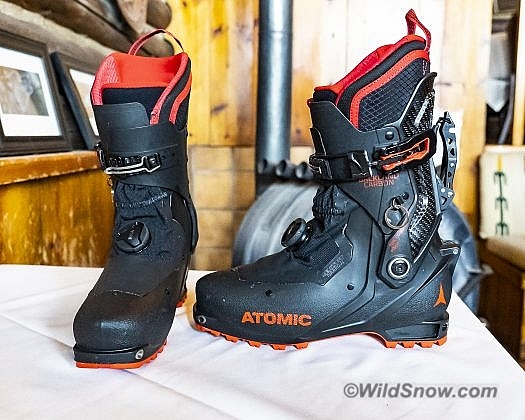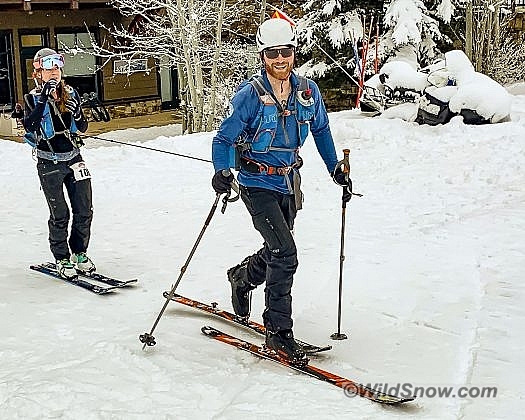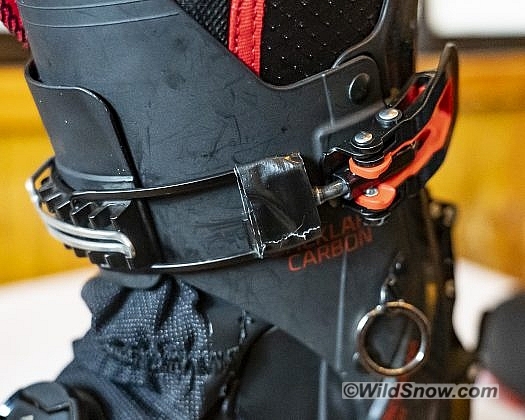Jamie Caudill
This post sponsored by our publishing partner Cripple Creek Backcountry.
First impressions of Atomic Backland Carbon Ski Touring Boot:
For years I have dodged the oncoming tide of flimsy “skimo” twigs with teeny low-tech bindings and neon morphsuits, But alas, the lure of lightweight long-distance touring has won out over the desire to slog uphill dragging five-to-ten pounds on each foot.
Sure enough, I found myself in the market for a lightweight pair of boots. I envisioned them wrapped in flashy euro-inspired neon stripes sporting an exotic name that is reminiscent of Italian race cars and spelled incorrectly like syclone, syber, or sychology. Instead, I landed on the 2019-2020 Atomic Backland Carbon (retail available this coming fall).
For months I sampled each and every brand and make of skimo boot that I could find and kept running into the same problem: they were too narrow. Sure, this can be fixed with custom molding, but there is only so far I can punch a boot before I look down in shame at the misshapen frankenboot that once was a well-machined piece of equipment, and am forced to accept the fact that my abused feet will never live up to the European standard of foot-beauty. And then there is the cost and time that boot fitting incurs. In contrast, as soon as I slipped my foot into the Memory Fit 3D goodness and 98mm last of the BL Carbon, I felt accepted. It was like a foot hug from a teddy bear.
If Batman wore ski-boots, these would be the ones; not only because they are black as night and one could easily fight crime in them, but they also boast all sorts of fancy high-tech gadgetry.
For example, the Boa system comprises a series of cables that act as constrictors (get it…) around the forefoot: you tighten by twisting the large knob on the front of the boot. It’s a cool idea, but it lacks in functionality. It felt flimsy, failed to secure my feet enough for demanding turns, and needed to be re-tightened throughout the day. The classic lever that can be snapped closed for the downhill and then released for the uphill is much more confidence inspiring. And, something so small as knowing exactly which catch you usually clip the lever onto is underappreciated.
The next gadgetry is the magnetic cuff-closure, designed to hold the fabric cuff in place around the liner, thus keeping snow out of the boot. Also a cool idea, but with the 78 degrees of motion available, the magnetic attachments came loose and flopped around on the outside of my test boots. Perhaps a longer cuff might fix this, but I think the magnets are a gimmick.
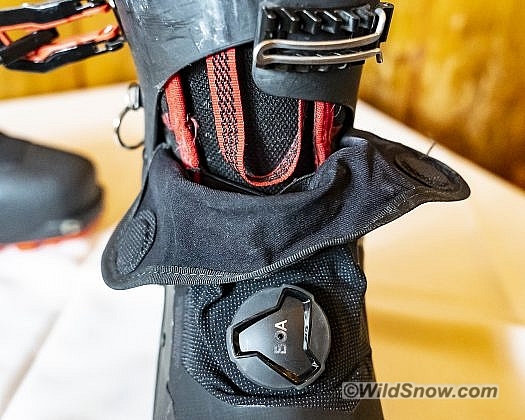
Disk shapes on the ears of the gaiter are magnets. They eliminate hook-and-loop but in my opinion are no better as they tend to detach.
As for the range of motion, 78 degrees is even more than some of the better touring boots in this category. Combine it with the Frictionless Pivot cuff-rivet bushing, and the walk-mode is comparable to that of a hiking boot. I was so impressed by how this felt, I performed several high ninja kicks in the boots, with great success.
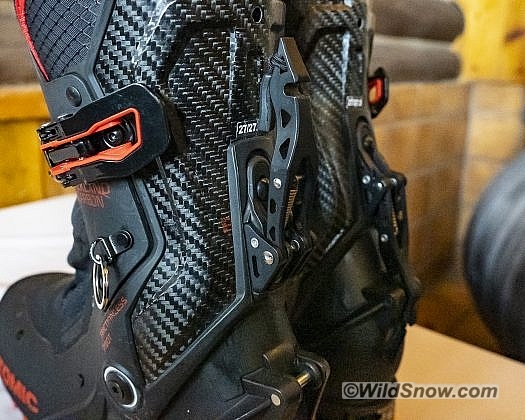
Lean lock bar is the now ubiquitous external type. At first I was skeptical as it does not have an extra safety catch, but I have not had a problem with it.
To transition into walk mode the lever on the back of the boot is flipped up by pulling the string attached to the end. When flipped back down, a small hook snaps onto a bar for ski-mode. At first, I did not trust the transition hook (not sure about the technical name). Besides the spring-tension, there is nothing to hold it in place, and I figured that it would be easy for it to come undone and send you sporadically into 78 degrees of ludicrous mode. However, once I took them on the most heinous wind-scoured 55-degree slope I could find, they quickly gained my confidence, and despite the claimed 110 flex, I was impressed with how they skied.
I trusted the Backland Carbon enough to use them in the Power of Four, a 24-mile 11,000 vert skimo race, and not once did they transition unexpectedly. But I would prefer a transition lever directly attached to the top buckle, as other brands provide.
The top buckle attachment was another issue for me. After a quick jaunt up the resort one day, I walked into work with the buckles in walk-mode. When I looked down, the wire bit was attached to the catch, but the buckle was detached from the wire. The wire is a sort of “G” shape which threads through a clasp that attaches the wire to the lever. Somehow it had been pulled loose, and the clasp was missing. Having this sort of thing occur during a race, or while deep in the backcountry, could be catastrophic. I was able to find the clasp under a bench and pulled out the engineering draft-table to fix the problem. The solution: duct-tape. I hope that Atomic finds a better way to secure these in place, but a hefty dose of tape does the trick for now.
The Backland Carbon is a state-of-the-art lightweight touring boot that is impressive, but is unlikely to be a game-changer. I would not be surprised if gadgetry such as the Boa system and magnetic cuff closure get trashed in the models of the future, but the carbon fiber reinforcement, extended range of motion, and fit are remarkable, and will are likely the future of the Backland series.
Cons:
Pros:
Jamie Caudill is a climbing guide, ski instructor, and photographer based in Carbondale, Colorado. To see more adventures on snow and stone, check out his instagram: https://www.instagram.com/jam.caudill
Beyond our regular guest bloggers who have their own profiles, some of our one-timers end up being categorized under this generic profile. Once they do a few posts, we build a category. In any case, we sure appreciate ALL the WildSnow guest bloggers!

